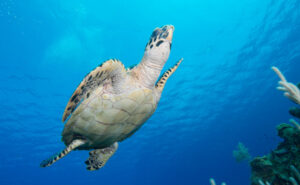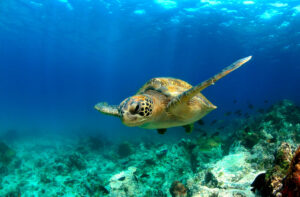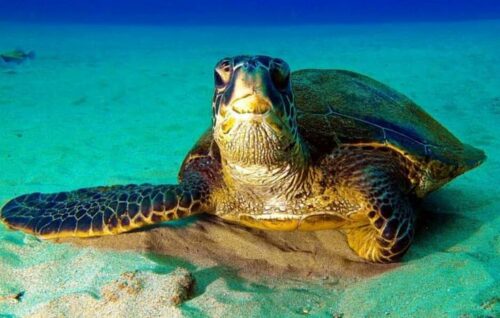If you’ve ever seen a sea turtle gliding through the ocean, you’ve probably been awestruck by its majestic beauty and graceful movements. But there’s one question that often pops up in the minds of curious onlookers: Do sea turtles have tails?
It’s a question that may seem simple at first, but there’s more to it than meets the eye. Sea turtles are fascinating creatures, and understanding the intricacies of their anatomy, including their tails, can unlock a world of incredible information about how they survive, thrive, and navigate the oceans.
In this article, we’ll dive into the depths of sea turtle biology to explore their tails—what they’re used for, how they differ between males and females, and how they contribute to the turtle’s overall survival strategy. By the end, you’ll not only know the answer to the question, “Do sea turtles have tails?” but also have a newfound appreciation for these ancient mariners.
Do Sea Turtles Have Tails?

Yes, Sea Turtles Have Tails. The tail of a sea turtle is a vital part of its body structure, although it’s not always the most noticeable feature. Positioned at the base of the turtle’s shell, near the cloaca (the single opening used for excretion and reproduction), the tail plays a critical role in the turtle’s overall anatomy and functionality.
While the tail may not be as prominent or as functional as the flippers, it is still essential in helping the turtle survive in the challenging environment of the ocean. You might be surprised to learn that these tails come in all shapes and sizes, with significant differences between male and female sea turtles.
The Function of a Sea Turtle’s Tail
Sea turtles are equipped with a variety of special adaptations to help them navigate the ocean, and the tail plays an important supporting role. However, contrary to what some may think, the tail is not used for swimming propulsion. Instead, it performs a range of functions that are crucial for the turtle’s survival.
Balance and Steering
One of the most important functions of a sea turtle’s tail is to help with balance and steering. As sea turtles swim through the water, their large flippers do most of the work in propelling them forward. But the tail serves as a stabilizing force, much like a rudder on a boat, allowing the turtle to maintain its direction and avoid drifting off course.
The tail’s shape and length contribute to the turtle’s ability to stay balanced while swimming, particularly when navigating strong currents or fast-moving waters. Without it, sea turtles would struggle to maintain their graceful movements in the water.
Mating and Reproduction
For male sea turtles, the tail serves an even more critical role during mating season. Male turtles have longer tails that they use to grasp the female’s shell during the act of mating. This allows the male to stabilize himself on the female’s back as they copulate, which can be a delicate and challenging process, particularly in the open ocean.
The tail is an essential tool in this reproductive process, helping the male secure his position during mating and ensuring that the female can carry out her reproductive duties without disruption. This is why you will often see males with noticeably longer tails than females.
Not for Propulsion
Unlike fish or other marine animals that use their tails for propulsion, sea turtles rely on their powerful flippers to swim. The tail, though important for balance and stability, does not have the strength or flexibility to push the turtle forward. Instead, the flippers are the key tools for a turtle’s movement.
This is one of the key differences between sea turtles and other marine creatures like sharks or dolphins, who rely on their tails for most of their swimming propulsion.
Anatomy of a Sea Turtle’s Tail
To fully understand the role of the tail, it’s essential to look at the structure of a sea turtle’s anatomy. The tail is part of the turtle’s hard shell, which is divided into the carapace (the top part) and the plastron (the bottom part). The tail sits near the rear of the shell and is relatively small in comparison to the turtle’s large, flippered body.
Male vs. Female Tails: What’s the Difference?
One of the most noticeable differences between male and female sea turtles is the length and shape of their tails. Male sea turtles have longer, thicker tails compared to females, and these tails extend beyond the edge of the shell. This is because males use their tails during mating to grasp onto the female’s shell.
Female sea turtles, on the other hand, tend to have shorter tails that are tucked neatly underneath the edge of the shell. These smaller tails are less pronounced since females do not need to use them for mating in the same way.
The difference in tail size between males and females is one of the most reliable ways to distinguish the two when they’re seen in the wild.
Common Myths About Sea Turtle Tails

Despite being a vital part of sea turtle anatomy, there are several misconceptions about their tails. Let’s clear up a few common myths:
1. Do Sea Turtles Use Their Tails for Defense?
While sea turtles have a strong, protective shell to defend themselves against predators, their tails are not used as a weapon. Some people might imagine that the tail could be used like a sword or a whip, but in reality, the tail plays no role in defense. Instead, sea turtles rely on their shell for protection and their speed for escaping threats.
2. Some Sea Turtles Don’t Have Tails
It’s a common myth that some species of sea turtles don’t have tails at all. While the size of the tail can vary between species, all sea turtles do have tails. In some cases, the tail may be less visible or shorter, but it’s always present. Some species, like the leatherback sea turtle, may have a shorter tail, but it’s still there.
Fun Facts About Sea Turtle Tails
Now that we’ve covered the basics of sea turtle tails, let’s look at some interesting and fun facts about them:
1. Tails Grow Over Time
Just like the rest of a sea turtle’s body, the tail grows as the turtle ages. Baby sea turtles are born with small tails that gradually lengthen as they mature. The tail’s growth is influenced by the turtle’s size and species, but all sea turtles go through this developmental process.
In addition to providing balance, a sea turtle’s tail helps with its ability to navigate through the ocean. The tail’s unique shape and positioning aid the turtle in adjusting its direction, especially when swimming through underwater currents or avoiding obstacles.
3. Sea Turtles Can Live Without Their Tails
While a sea turtle’s tail is important, they can technically live without it. However, losing the tail could affect the turtle’s ability to swim as efficiently or reproduce. Tails are important for the turtle’s overall health, but they are not absolutely vital for survival in the same way as their flippers or shell.
Why Understanding Sea Turtle Anatomy Is Important
Understanding the anatomy of sea turtles, including the function of their tails, is not just for biological curiosity—it’s also essential for conservation efforts. By learning how sea turtles use their bodies, researchers can better understand their behavior, habitat preferences, and reproductive strategies. This information is critical in protecting them and ensuring their survival in an increasingly challenging world.
Conservation Efforts and the Importance of the Tail
Sea turtles are facing numerous threats, including habitat destruction, climate change, and illegal poaching. The more we understand about their anatomy and biology, the better equipped we are to protect them.
Tail damage, for example, could indicate environmental issues such as entanglement in fishing nets or collision with boats. Conservation organizations use this information to monitor the health of sea turtle populations and develop effective strategies for their protection.
How to Spot a Sea Turtle in the Wild (Including Tail Identification)
If you’re lucky enough to encounter a sea turtle in the wild, you may be able to identify it by looking at its tail. While not all sea turtles are easy to spot, there are a few signs you can look for:
- Tail Length: Males will have longer tails that extend beyond the edge of the shell, while females’ tails are shorter and tucked underneath.
- Behavior: Pay attention to mating behaviors. If you see a male clasping onto a female’s shell, you can be sure the tail is being used in the process.
Being able to spot and identify these features will help you appreciate the diversity of sea turtles and their remarkable adaptations to ocean life.
Conclusion
So, do sea turtles have tails? The answer is yes! While their tails are not as prominent as their flippers, they play important roles in balance, mating, and navigation. Understanding how sea turtles use their tails helps us appreciate the unique and incredible ways these creatures survive in the vast ocean.
By gaining insights into their anatomy, including the tail, we can support conservation efforts and ensure these magnificent creatures continue to thrive in our oceans for generations to come.
If you’re fascinated by sea turtles and want to learn more about their role in the ecosystem, consider supporting marine conservation efforts or learning more about how we can protect these endangered creatures.

